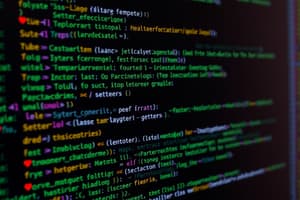Podcast
Questions and Answers
What are the primary streams used for input and output in C++?
What are the primary streams used for input and output in C++?
- std::input, std::output, std::error
- cin, out, err
- cin, cout, cerr (correct)
- input, output, error
Which operator is used in C++ to allocate memory dynamically?
Which operator is used in C++ to allocate memory dynamically?
- calloc
- alloc
- new (correct)
- malloc
Which of the following accurately describes a C++ class?
Which of the following accurately describes a C++ class?
- A data structure that can only hold integers
- A blueprint for creating instances with data and methods (correct)
- A set of functions for performing mathematical operations
- A collection of related global variables
What is the purpose of the 'delete' operator in C++?
What is the purpose of the 'delete' operator in C++?
What is a crucial difference between C structs and C++ classes?
What is a crucial difference between C structs and C++ classes?
In which file type are C++ member functions typically defined?
In which file type are C++ member functions typically defined?
What is the purpose of the 'using namespace std;' directive in C++?
What is the purpose of the 'using namespace std;' directive in C++?
What distinguishes member functions in C++ from methods in Java?
What distinguishes member functions in C++ from methods in Java?
What is the primary purpose of converting structs to classes in Object Oriented Programming?
What is the primary purpose of converting structs to classes in Object Oriented Programming?
Which of the following lines correctly defines a private member variable in the Rectangle class?
Which of the following lines correctly defines a private member variable in the Rectangle class?
What would happen if you tried to access the width variable in the main function as shown: r.width = 10;
What would happen if you tried to access the width variable in the main function as shown: r.width = 10;
What is the purpose of the default constructor in the Rectangle class?
What is the purpose of the default constructor in the Rectangle class?
Which statement about public members in the Rectangle class is true?
Which statement about public members in the Rectangle class is true?
What should be done to define a method to calculate the area of the Rectangle?
What should be done to define a method to calculate the area of the Rectangle?
Why can't the following line of code compile? 'cout << r.height;'.
Why can't the following line of code compile? 'cout << r.height;'.
What role do access specifiers play in class definitions?
What role do access specifiers play in class definitions?
Flashcards
Object-Oriented Programming (OOP)
Object-Oriented Programming (OOP)
A programming paradigm focused on objects, which are encapsulations of data and methods that operate on the data.
Class in C++
Class in C++
A blueprint for creating objects. It defines the data (attributes) and the actions (methods) objects of that class can perform.
Public Members
Public Members
Members of a class (attributes or methods) that can be accessed from outside the class.
Private Members
Private Members
Signup and view all the flashcards
Constructor
Constructor
Signup and view all the flashcards
Rectangle Class
Rectangle Class
Signup and view all the flashcards
Encapsulation
Encapsulation
Signup and view all the flashcards
Private Attribute Access
Private Attribute Access
Signup and view all the flashcards
Method
Method
Signup and view all the flashcards
Attribute
Attribute
Signup and view all the flashcards
C++ Classes
C++ Classes
Signup and view all the flashcards
Data Members
Data Members
Signup and view all the flashcards
Member Functions
Member Functions
Signup and view all the flashcards
Object
Object
Signup and view all the flashcards
Header (.h) file
Header (.h) file
Signup and view all the flashcards
Source File (.cpp/.cxx/.cc/.C)
Source File (.cpp/.cxx/.cc/.C)
Signup and view all the flashcards
Dynamic Memory Management
Dynamic Memory Management
Signup and view all the flashcards
new operator
new operator
Signup and view all the flashcards
delete operator
delete operator
Signup and view all the flashcards
iostream library
iostream library
Signup and view all the flashcards
cin
cin
Signup and view all the flashcards
cout
cout
Signup and view all the flashcards
cerr
cerr
Signup and view all the flashcards
Study Notes
Systems Programming Lecture 12: C++ Classes
- Lecture covers C++ classes, a key component of object-oriented programming.
- Summative submission points involve executable and library files, report PDFs, Makefile rules, code quality, output generation, example result visualizations, and result timing/memory profile graphs.
Key Differences Between C and C++
- C++ uses the iostream library for input/output, while C relies on separate functions.
- C++ employs cin, cout, and cerr for input/output, whereas C requires different I/O functions.
- C++ employs the << and >> operators for stream input/output.
- C++ uses namespaces, like std::, to group elements.
Dynamic Memory Allocation (new and delete)
- In C++, dynamic memory allocation is simplified compared to C.
newallocates space on the heap, eliminating the need for size specification.deletefrees up allocated memory.- C uses
mallocandcallocfor heap allocation, andfreeto deallocate.
Object Classes in C++
- C++ classes contain data members (attributes) and member functions (methods).
- C++ classes, similar to Java, encapsulate data and methods that operate on it.
- C++ classes do not utilize a garbage collector, unlike Java.
Object Classes in C++ (Declaration and File Organization)
- Typically, declared in a header (.h) file.
- Member functions defined in a source (.cpp) file.
- Typical source file extensions include .cpp, .cxx, .cc, and .C.
Object Oriented Programming (OOP) in C++
- In OOP, "objects" (instances of classes) can encapsulate data and methods operating on it.
- OOP is not readily achievable with C-style structs.
C++ Class Declaration Example
- Classes, structs, and
public:sections are used to create data members (e.g.,width,height). public:members can be accessed outside the class.private:members cannot be accessed outside the class.
C++ Constructors
- Constructors initialize objects.
- Default constructors can be specified explicitly.
- Some examples given show initialization lists within constructors, which allow more readable constructor code and improve efficiency by using compile-time initialization rather than run-time initialization (e.g.,
Rectangle r(2,5)).
C++ Methods (Functions)
- Functions, also known as methods, are defined as part of a class.
- A class can define multiple methods to operate on its data (e.g., the
Rectangle::Area()method for instance).
C++ Public Methods: Print()
- The
Rectangle::Print()method shows how to output the class member variables (width and height).
Default Constructor and Initialization Lists
- Initialization lists initialize data members during object creation.
- The
Rectangleclass can utilize initialization lists for efficient and precise member variable assignment.
C++ Destructors
- Destructors clean up resources when an object is destroyed.
- Destructors are automatically invoked.
- C++ destructors are designated with a tilde (
~) preceding the class name (e.g.,~Rectangle). - Automatic variables are destroyed automatically, so a destructor may not need code, though it may still sometimes be beneficial.
Passing Variables (by Value, Pointer, Reference)
- In C++, variables can be passed to functions by value, pointer, or reference.
- Pass by value does not affect the original variable outside the function.
- Pass by pointer changes the original value because the function obtains the memory address.
- Pass by reference changes the original value because the reference is an alias for the original variable.
References vs. Pointers
- References are aliases for variables; pointers hold memory addresses.
- References cannot be NULL, while pointers can.
- References have stricter value semantics.
- Pointers have greater flexibility in memory management.
C++ const Keyword
- The
constkeyword designates variables as having constant values. - Functions or variables preceded by
constmean the values or behaviors of those functions/variables cannot be changed.
Function Overloading
- Function overloading in C++ permits multiple functions with identical names but distinct parameter lists—allowing functions to perform identical operations on various data types.
Operator Overloading
- Operator overloading in C++ enables you to redefine how operators, such as
+,-,<<, or>>, behave for specific classes.
Friend functions
- A friend function isn't a member of a class, yet it has access to private class members.
- Friend functions are declared explicitly within a class as friends.
C++ Rules of Three/Five
- If a class defines a copy constructor, a destructor, or any of the other "copy" functionalities, it should likely define all of them.
Move Semantics
- Move semantics were introduced in C++11.
- The
moveconstructor is typically used to transfer resources from a temporary object to a new one (e.g., when returning a locally created object from a function). - Move Semantics are generally a good practice, ensuring objects are not unnecessarily copied in potentially expensive operations.
- Copy elision (or return value optimization) is a useful optimization that often eliminates the need for explicit move constructors/operators.
Summary (C++ Programming)
- The study material covers core C++ features: classes, pointers/references, function overloading, operators, the Rule of Three/Five, move semantics, and object destruction.
Studying That Suits You
Use AI to generate personalized quizzes and flashcards to suit your learning preferences.




